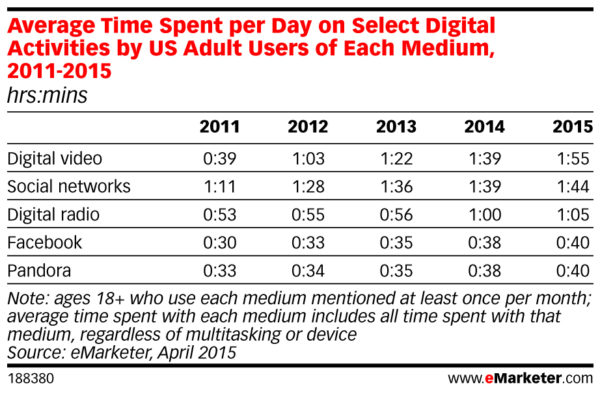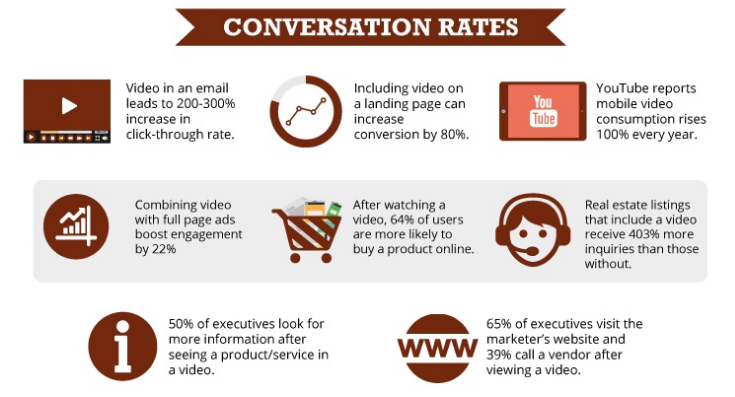The Growth of Video Marketing: More Important Than Ever in 2017
How much video marketing is your brand doing right now?
If the answer is zero, well it’s time to start. Because if you don’t, then you’re going to be missing out on one of the biggest marketing trends set to skyrocket in 2017.
In fact, according to Entrepreneur, by 2019 80 percent of online content will be video. That’s a pretty incredible stat. So, it shouldn’t go unnoticed.
But, you might be asking, since when has video become such a big thing? After all, there’s still no shortage of written content and social media being produced.
Great question. And in this post, we’re going to cover why video marketing has been such a big growth engine over the last year or two, and why it’s set to be the biggest distribution channel marketers can use in the coming year.
Let’s get started.
Time Spent Online
It shouldn’t come as a big surprise that the amount of time people are spending online has grown quite a bit over the years. Now, with the advent of smartphones and tablets, plus the extreme growth of streaming sites like Netflix and Hulu, more and more people are watching online content than ever before.
When you look at the numbers, you can really see just how much of this breakdown leans towards video. Take a look at this graph from eMarketer:

Now, the average user is spending just shy of 2 hours per day watching video online. While every medium has seen growth since 2011, none have grown as much as digital video. It beats social networks, digital radio, and even Facebook.
This is great news for marketers who are looking to find new channels to reach their customers that make a big impact and aren’t incredibly expensive.
And, more and more sites are incorporating video within them. Look at the social media sites. Facebook, Twitter, and Instagram all feature video options on their sites. Twitter has spent much of the fall of 2016 experimenting with live streaming events from Thursday night NFL games to news.
Then, of course, there is the massive growth of Snapchat. With 10 billion video views each day by users, it has helped revolutionize video content for consumers. It’s about time brands have decided to follow along.
Video content, especially on social media channels like Instagram and Snapchat has provided marketers with an amazing way to reach their consumers. Video feels much more personal to potential consumers on these channels. Thus video content on social media can have a much higher level of engagement than other types of marketing.
The Rise of YouTube
The growth of YouTube has helped push the dramatic rise of video content as well. Just take a look at some of these incredible YouTube statistics:
- YouTube has over a billion users
- On mobile, the average viewing session is now more than 40 minutes.
- More than half of YouTube views come from mobile devices.
- YouTube overall, and even YouTube on mobile alone, reaches more 18-34 and 18-49 year-olds than any cable network in the U.S.
Currently, the only channel that sees more daily hits than YouTube is Google. In fact, YouTube is also the #2 search engine in the world.
Right now, YouTube has been projected to see approximately 500 hours of content being uploaded to the site each minute. A massive growth from 2007 when the site launched and saw an average of 6 hours of content uploaded per minute.
Unsurprisingly, because YouTube has been such a growth channel, both brands and individual people have been able to benefit from it. Just this month, YouTube star Casey Neistat announced that his video app Beme had been acquired by CNN and he would begin to make content for them.
Marketers are Taking Notice
In Hubspot’s recently released State of Inbound 2016 report, video was set to play a large part of the strategy plan for brands and marketers in 2017.
When asked: What content distribution channels do you plan to add to your marketing efforts in the next 12 months?
This was the breakdown of the responses:
- 48% YouTube
- 39% Facebook video
- 33% Instagram
- 20% Messaging apps
- 15% Podcasts
- 13% Snapchat
Notice a trend there? Beyond the heavy social media presence here, every single one of these distribution channels have a large (or solely) video component with the exception of podcasting.
The majority of marketers are looking to add channels that support video in their marketing efforts in 2017.
Of course, there’s a reason why marketers are starting to love video, because video provides results.
Check out this infographic from Hubspot:

The conversion rates on video are incredible. Users are more likely to buy products online, call vendors, visit marketer’s websites, boost engagement, and increase click-through rates.
The important thing to note about video marketing is that now because it’s everywhere, it’s not limited to just the ‘big’ brands. Small and local businesses can and should get into video marketing because they can dramatically increase traffic and conversions with something as simple as a 2-minute video shot from a smart phone. Massive amounts of technical knowledge or equipment aren’t needed.
Final Thoughts
It’s easy to see why video is getting huge. The real question is, what is your brand going to do to jump into it? Right now is the best time to do it, because any brands that aren’t already jumping on the video marketing bandwagon now are only going to be left behind in the next year.
Is your brand already seeing success with video marketing? Let us know in the comments!




